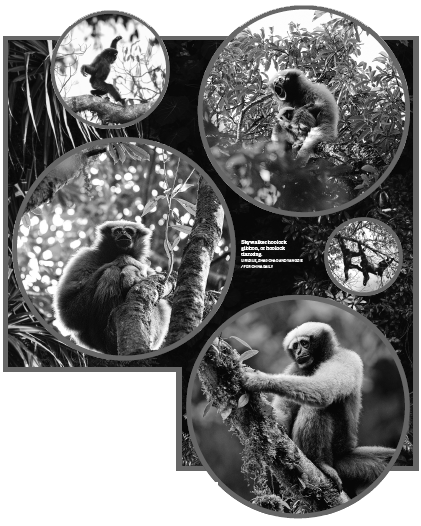Natural curiosity

A rainforest-themed room escape game is set in a shopping mall, where participants have to solve five puzzles related to wildlife to identify the master of the rainforest.
Tasks include finding the number on the wings of a bug, counting the legs of a real crab and flipping the number plate inside the cage that has a nontoxic snake.
The game is part of a nature themed exhibition held in Beijing's Chaoyang Joy City from April 22 to May 23. The exhibition, organized by Naturewin, also includes a wildlife photo exhibition and a market highlighting the benefits of ecology.
Founded in 2016, Naturewin is an institute that focuses on nature education, global eco-travel and ecological protection consultation. Zhao Chao, founder of the institute, said that some of the profits from the market will be used to sponsor frontline wildlife conservation in China.
Zhao thinks the children of this era are immersed in an electronic environment and consequently have less access to nature.
Besides the traditional way of introducing children to nature, he says he needs to find creative ways of educating children, and the exhibition is one way to do this.
"It's a reproducible mode that we can move to many other places," he says.
"To let more kids like nature, they will care for nature and learn about nature. So, when they grow up, even though they don't find a career path in this field, when they make decisions whether at their work or for their family, they may choose a more sustainable way," he says.
Cloud Mountain Conservation, an NGO that focuses on gibbon protection in Yunnan province, also coorganized the exhibition.
Yan Lu, cofounder of the NGO, says the exhibition aims to let people feel the responsibility to protect and care for the nature through realizing its beauty.
Through interpretation by volunteers and interaction in the escape game, Yan hopes both the parents and their children can find the beauty of the animals they used to think are ugly, including some insects and snakes.
"No matter how the animals look like, they have an irreplaceable function and place in the whole ecosystem," she says.
Yan notices one mother brought her child to the exhibition, and she asked Yan many questions about gibbon protection, and the next day, she signed up to be a volunteer of the exhibition.
"I'm touched that through this kind of event we can really influence people, especially the young, who might join the wildlife protection work in the future," she says.
Furthermore, Yan hopes to bring more people closer to nature-to visit remote areas and connect with minorities.
Of course, the final answer as to who is the master of the rainforest is what Yan and her teammates have been protecting for years, the gibbons, more specifically, the hoolock tianxing.
In January of 2017, Fan Pengfei from School of Life Sciences, Sun Yat-Sen University in China, who is also cofounder of Cloud Mountain Conservation, and other scientists announced the discovery of a new species of primate, the skywalker hoolock gibbon, or hoolock tianxing in the American Journal of Primatology.
According to Fan, they chose this English name partly because the Chinese characters of its scientific name, tianxing, means "heaven's movement", and also the scientists are fans of Star Wars.
American actor Mark Hamill, the original Luke Skywalker in the film franchise took note of the name -he said on twitter that he was so proud to have a new jungle Jedi named after his character.
Fan and scientists think that this new species should be categorized as endangered under the International Union for Conservation of Nature criteria.
"There are around 1,800 wild pandas in China-which is more than the total number of all six species of gibbons in China. There are fewer than 1,500 gibbons and only around 150 are skywalker hoolock gibbons," Yan says. "The public barely know this fact."
According to Yan, most gibbons in China live in protection areas, but the reason they fear for the future of the skywalker hoolock gibbon is that half of them live outside protection areas.
There are only two zoos in China, one in Beijing and the other one in Kunming, Yunnan province, that have skywalker hoolock gibbons.
Yan says there was a time when poaching was the biggest threat to wildlife in China. But, Yan adds, as the laws have been constantly improving and public awareness of the importance of protection has evolved, there is less and less poaching.
"Now the main threat to wildlife is habitat loss and degradation," she says.
This is especially true for gibbons. The species requires habitat quality, a complete primeval forest system to contain their necessities of survival-food, trees, sleep and a connected canopy.
"The habitat protection, and human needs and the development of cities and towns can hardly be fully coordinated, and habitat recovery needs time to achieve results," Yan says.
"Under the circumstances that the wildlife habitat and human living space have already intertwined, it's worth to discuss how to keep the biodiversity," she adds. "We need to find a balanced model between protection and development."
She thinks it's important to study gibbons as they are a good check sample for human society. However, it's quite challenging to study gibbons. Unlike birds that you could find their nests or leopard which you could place an infrared camera, gibbons need to be followed by human, she explains.
The gibbons spend most of their time living in the treetops, swinging through forests with their forelimbs, and rarely spend any time on the ground.
"We need to observe the gibbon from 5 am to 5 pm, and record its behavior every five minutes," she says. "In each month we need to observe at least six full days, and we have to keep observing the same gibbon family for years."
There is another challenge -researchers have to take one to two years to let gibbons get used to them being around so that they can record their natural behavior.
According to Yan, gibbons can recognize themselves in the mirror and they have the level of intelligence of a five-year-old child.
"Because they live on the trees throughout the year, they have to learn survival skills for three to five years from their moms to tell which plant can be eaten as food or what kind of branch they can grab that will hold them without breaking," she says.
Yan says when scientists did field study in Yunnan in 1970s, they could still hear gibbons singing around, and she hopes in the future, people can hear the skywalkers' wonderful songs again.


Today's Top News
- Xi urges central SOEs to contribute more to Chinese modernization
- Five continents, five rhythms in 2025
- Lawmakers review draft law to expand childcare services
- China's new-style tea brands find a hot new market in US
- Xi extends congratulations to Chilean president-elect
- Japan urged to stop provocative moves






























